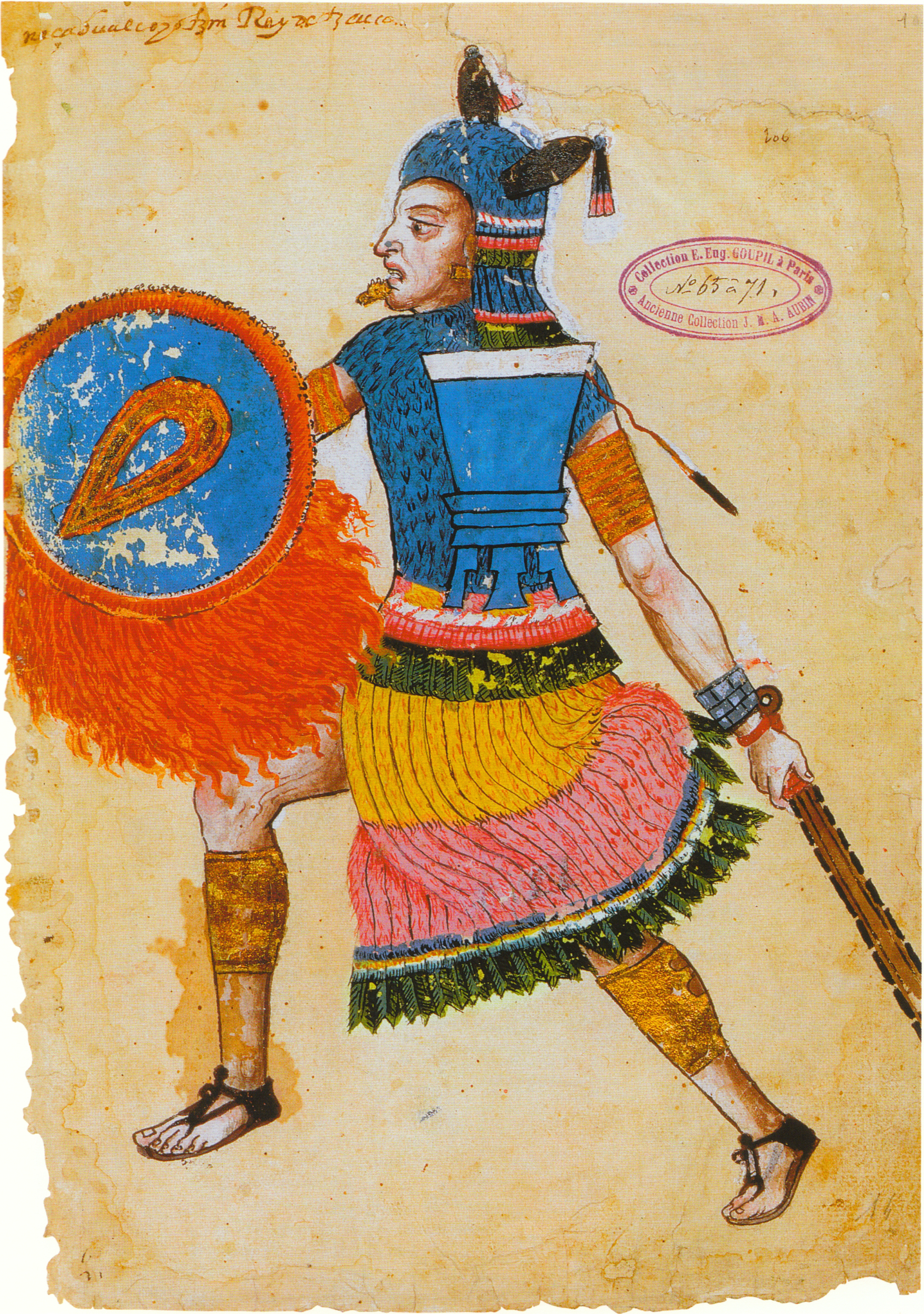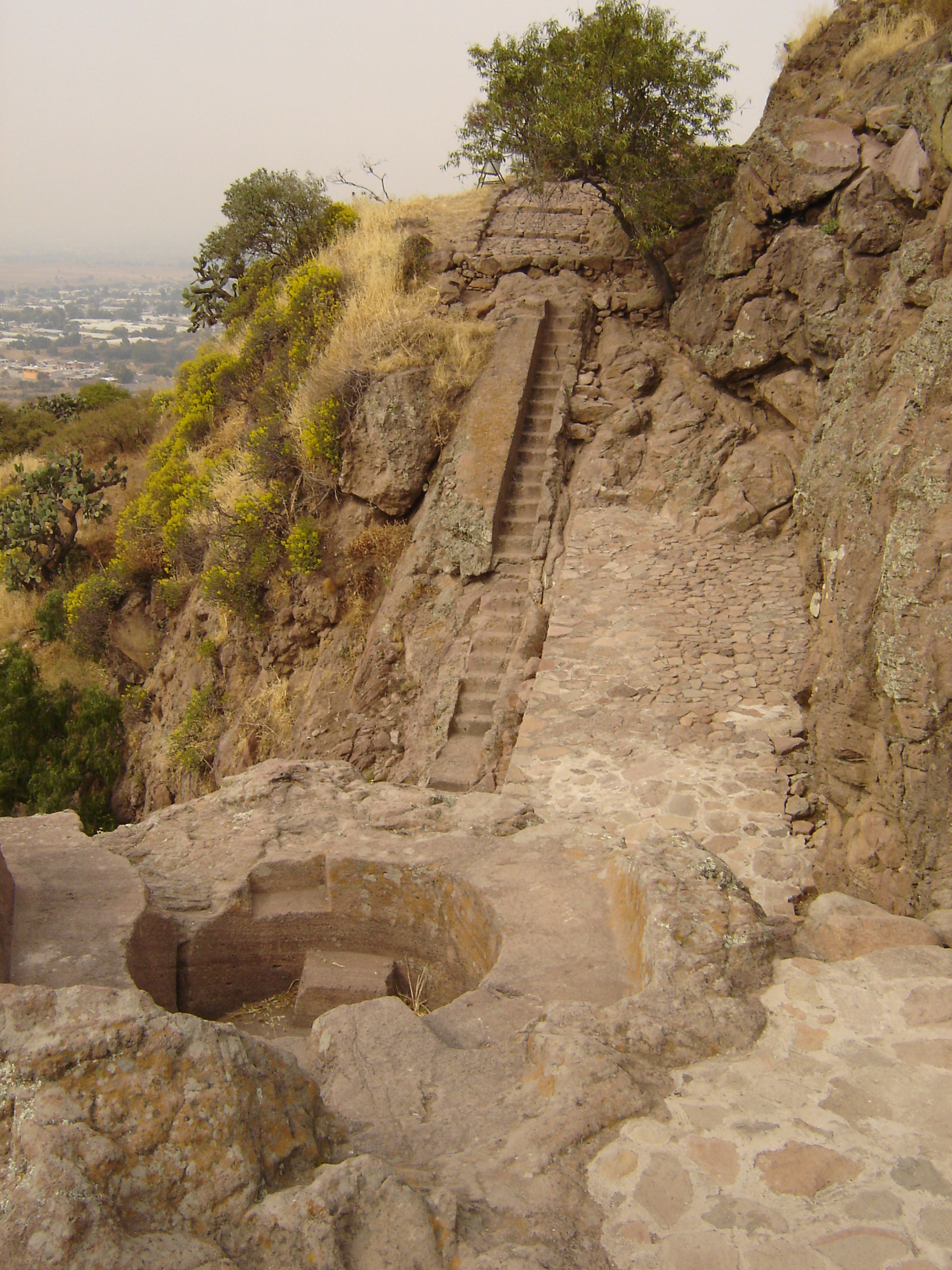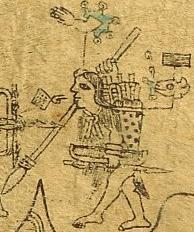|
Nezahualpiltzintli
Nezahualpilli (Nahuatl for "fasting prince"; 1464–1515, ) was king (''tlatoani'') of the Mesoamerican city-state of Texcoco, elected by the city's nobility after the death of his father, Nezahualcoyotl, in 1472. Nezahuapilli's mother was Azcalxochitzin, who married Nezahualcoyotl after the death of her first husband, King Cuahcuauhtzin of Tepechpan. Like his father, he was a poet, was considered a sage, and had the reputation of being a fair ruler. Only one of his poems survives: "''Icuic Nezahualpilli yc tlamato huexotzinco''" ("Song of Nezahualpilli during the war with Huexotzinco"). His court was a haven for astronomers, engineers, and soothsayers. During his reign, he abolished capital punishment for a number of crimes and struggled to keep the political independence of Texcoco during the increasing centralization of Aztec power in Tenochtitlán. When he told Moctezuma II that the Texcocan wise men had foretold foreign dominion over the Valley of Mexico, the emperor chall ... [...More Info...] [...Related Items...] OR: [Wikipedia] [Google] [Baidu] |
Nezahualcoyotl (tlatoani)
Nezahualcoyotl ( nci, Nezahualcoyōtl , ) (April 28, 1402 – June 4, 1472) was a scholar, philosopher (tlamatini), warrior, architect, poet and ruler (''tlatoani'') of the city-state of Texcoco in pre-Columbian era Mexico. Unlike other high-profile Mexican figures from the century preceding Spanish conquest of the Aztec Empire, Nezahualcoyotl was not fully Mexica; his father's people were the Acolhua, another Nahuan people settled in the eastern part of the Valley of Mexico, on the coast of Lake Texcoco. His mother, however, was the sister of Chimalpopoca, the Mexica king of Tenochtitlan. He is best remembered for his poetry, but according to accounts by his descendants and biographers, Fernando de Alva Cortés Ixtlilxóchitl and Juan Bautista Pomar, he had an experience of an "Unknown, Unknowable Lord of Everywhere" to whom he built an entirely empty temple in which no blood sacrifices of any kind were allowed — not even those of animals. However, he allowed human sacrifices ... [...More Info...] [...Related Items...] OR: [Wikipedia] [Google] [Baidu] |
Tlatoque
''Tlatoani'' ( , "one who speaks, ruler"; plural ' or tlatoque) is the Classical Nahuatl term for the ruler of an , a pre-Hispanic state. It is the noun form of the verb "tlahtoa" meaning "speak, command, rule". As a result, it has been variously translated in English as "king", "ruler", or "speaker" in the political sense. Above a tlahtoani is the ''Weyi Tlahtoani,'' sometimes translated as "Great Speaker", though more usually as "Emperor" (the term is often seen as the equivalent to the European "great king"). A ' () is a female ruler, or queen regnant. The term refers to "vice-leader". The leaders of the Mexica prior to their settlement are sometimes referred to as , as well as colonial rulers who were not descended from the ruling dynasty. The ruler's lands were called , and the ruler's house was called ''Nahuatl dictionary'' (1997). Wired humanities project. Retrieved January 1, 2012, frolink/ref> The city-states of the Aztec Empire each had their own tlatoani, or lea ... [...More Info...] [...Related Items...] OR: [Wikipedia] [Google] [Baidu] |
Tlatoani
''Tlatoani'' ( , "one who speaks, ruler"; plural ' or tlatoque) is the Classical Nahuatl term for the ruler of an , a pre-Hispanic state. It is the noun form of the verb "tlahtoa" meaning "speak, command, rule". As a result, it has been variously translated in English as "king", "ruler", or "speaker" in the political sense. Above a tlahtoani is the ''Weyi Tlahtoani,'' sometimes translated as "Great Speaker", though more usually as "Emperor" (the term is often seen as the equivalent to the European "great king"). A ' () is a female ruler, or queen regnant. The term refers to "vice-leader". The leaders of the Mexica prior to their settlement are sometimes referred to as , as well as colonial rulers who were not descended from the ruling dynasty. The ruler's lands were called , and the ruler's house was called ''Nahuatl dictionary'' (1997). Wired humanities project. Retrieved January 1, 2012, frolink/ref> The city-states of the Aztec Empire each had their own tlatoani, or l ... [...More Info...] [...Related Items...] OR: [Wikipedia] [Google] [Baidu] |
Hueyi Tlatoani
''Tlatoani'' ( , "one who speaks, ruler"; plural ' or tlatoque) is the Classical Nahuatl term for the ruler of an , a pre-Hispanic state. It is the noun form of the verb "tlahtoa" meaning "speak, command, rule". As a result, it has been variously translated in English as "king", "ruler", or "speaker" in the political sense. Above a tlahtoani is the ''Weyi Tlahtoani,'' sometimes translated as "Great Speaker", though more usually as "Emperor" (the term is often seen as the equivalent to the European "great king"). A ' () is a female ruler, or queen regnant. The term refers to "vice-leader". The leaders of the Mexica prior to their settlement are sometimes referred to as , as well as colonial rulers who were not descended from the ruling dynasty. The ruler's lands were called , and the ruler's house was called ''Nahuatl dictionary'' (1997). Wired humanities project. Retrieved January 1, 2012, frolink/ref> The city-states of the Aztec Empire each had their own tlatoani, or l ... [...More Info...] [...Related Items...] OR: [Wikipedia] [Google] [Baidu] |
Tlatoani Of Texcoco
This is a list of Mesoamerican rulers of the ''altepetl'' of Tetzcoco from the time the city began being ruled by ''tlatoque'' in 1298 to the end of the line of indigenous rulers. From the early 15th century to 1521, Tetzcoco was one of the three leading members of the Triple Alliance, commonly known as the Aztec Empire, but was often subservient to the rulers of Tenochtitlan. The Aztec Empire was conquered by Spain in 1521, but the Spanish colonial authorities continued to appoint ''tlatoque'' of Tetzcoco until the office was abolished in 1564. Pre-colonial rulers (1298–1521) Early Tetzcoco (1298–1431) The ''tlatoque'' of Tetzcoco were descendants and successors of earlier ''tlatoque'' of the Chichimeca, succeeding Xolotl (1172–1232), Nopaltzin (1232–1263) and Tlotzin (1263–1298). In the Triple Alliance (1431–1521) Colonial period (1521–1564) The line of ''tlatoque'' continued in Tetzococo after the Spanish conquest. Adept at navigating the new Span ... [...More Info...] [...Related Items...] OR: [Wikipedia] [Google] [Baidu] |
Tlamatini
''Tlamatini'' (plural ''tlamatinime'') is a Nahuatl language word meaning "someone who knows something", generally translated as "wise man". The word is analyzable as derived from the transitive verb ''mati'' "to know" with the prefix ''tla-'' indicating an unspecified inanimate object translatable by "something" and the derivational suffix ''-ni'' meaning "a person who are characterized by ...": hence tla-mati-ni "a person who is characterized by knowing something" or more to the point "a knower". The famous Nahuatl language translator and interpreter Miguel León-Portilla refers to the ''tlamatini'' as philosophers and they are the subject of his book ''Aztec Thought and Culture''. See also * Shaman Notes References * Internet Archive copy * {{cite book , author=León-Portilla, Miguel , author-link=Miguel León-Portilla , year=1963 , title=Aztec Thought and Culture: A Study of the Ancient Náhuatl Mind , series=Civilization of the American Indian series, #67, transla ... [...More Info...] [...Related Items...] OR: [Wikipedia] [Google] [Baidu] |
Texcoco (altepetl)
Tetzcoco (Classical Nahuatl: ''Tetzco(h)co'' ) was a major Acolhua altepetl (city-state) in the central Mexican plateau region of Mesoamerica during the Late Postclassic period of pre-Columbian Mesoamerican chronology. It was situated on the eastern bank of Lake Texcoco in the Valley of Mexico, to the northeast of the Aztec capital, Tenochtitlan. The site of pre-Columbian Tetzcoco is now subsumed by the modern Mexican ''municipio'' of Texcoco and its major settlement, the city formally known as Texcoco de Mora. It also lies within the greater metropolitan area of Mexico City. Pre-Columbian Tetzcoco is most noted for its membership in the Aztec Triple Alliance. At the time of the Spanish conquest of the Aztec Empire, it was one of the largest and most prestigious cities in central Mexico, second only to the Aztec capital, Tenochtitlan. A survey of Mesoamerican cities estimated that pre-conquest Tetzcoco had a population of 24,000+ and occupied an area of 450 hectares. The ... [...More Info...] [...Related Items...] OR: [Wikipedia] [Google] [Baidu] |
1515 Deaths
__NOTOC__ Year 1515 ( MDXV) was a common year starting on Monday (link will display the full calendar) of the Julian calendar. Events January–June * January 25 – Francis I of France is crowned (reigns until 1547). * May 13 – Mary Tudor, Queen of France, and Charles Brandon, 1st Duke of Suffolk, are officially married at Greenwich (near London). * June 13 – Battle of Turnadag: The army of Ottoman sultan Selim I defeats the beylik of Dulkadir under Bozkurt of Dulkadir. July–December * July 2 – Manchester Grammar School is endowed by Hugh Oldham, the first free grammar school in England. * July 22 – At the First Congress of Vienna, a double wedding takes place to cement agreements. Louis, only son of King Vladislaus II of Hungary, marries Mary of Austria, granddaughter of Maximilian I, Holy Roman Emperor; and Mary's brother, Archduke Ferdinand, marries Vladislaus' daughter, Anna. * August 25 – Conquistador Diego Velázque ... [...More Info...] [...Related Items...] OR: [Wikipedia] [Google] [Baidu] |
1464 Births
Year 1464 ( MCDLXIV) was a leap year starting on Sunday (link will display the full calendar) of the Julian calendar. It is one of eight years (CE) to contain each Roman numeral once (1000(M)+(-100(C)+500(D))+50(L)+10(X)+(-1(I)+5(V)) = 1464). Events January–December * April 25 – Battle of Hedgeley Moor in England: Yorkist forces under John Neville defeat the Lancastrians under Sir Ralph Percy, who is killed. * May 1 – Edward IV of England secretly marries Elizabeth Woodville, and keeps the marriage a secret for five months afterwards. * May 15 – Battle of Hexham: Neville defeats another Lancastrian army, this one led by King Henry and Queen Margaret themselves. This marks the end of organized Lancastrian resistance for several years. * June 11 – A 15-year-truce between the kingdoms of England and Scotland is signed. * June 18 – Pope Pius II himself shoulders the cross of the Crusades, and departs for Ancona to participate in person. He names ... [...More Info...] [...Related Items...] OR: [Wikipedia] [Google] [Baidu] |
Tlatoque Of Texcoco
This is a list of Mesoamerican rulers of the ''altepetl'' of Tetzcoco from the time the city began being ruled by ''tlatoque'' in 1298 to the end of the line of indigenous rulers. From the early 15th century to 1521, Tetzcoco was one of the three leading members of the Triple Alliance, commonly known as the Aztec Empire, but was often subservient to the rulers of Tenochtitlan. The Aztec Empire was conquered by Spain in 1521, but the Spanish colonial authorities continued to appoint ''tlatoque'' of Tetzcoco until the office was abolished in 1564. Pre-colonial rulers (1298–1521) Early Tetzcoco (1298–1431) The ''tlatoque'' of Tetzcoco were descendants and successors of earlier ''tlatoque'' of the Chichimeca, succeeding Xolotl (1172–1232), Nopaltzin (1232–1263) and Tlotzin (1263–1298). In the Triple Alliance (1431–1521) Colonial period (1521–1564) The line of ''tlatoque'' continued in Tetzococo after the Spanish conquest. Adept at navigating the new Span ... [...More Info...] [...Related Items...] OR: [Wikipedia] [Google] [Baidu] |
Akademische Druck- Und Verlagsanstalt
:''There also were unrelated publishing houses in Stuttgart and in (East-)Berlin, and there is the (JAVG).'' The Akademische Druck- und Verlagsanstalt (ADEVA) is an Austrian book publisher in Graz that specialises primarily in publishing lavish facsimile editions. History The publishing house was founded by Paul Struzl (1914–1973) in Graz. Trained as a typesetter and with a doctorate in economics, Struzl began work in 1947 by acquiring a Rotaprint machine from the province of Styria and founding an offset printing company under the name of his father-in-law Franz Hacker. In 1949, Struzl founded the Akademische Druck- und Verlagsanstalt and brought in the printing works he had established in 1947.Karlpeter Elis''Steirische Druckgeschichte'' 1982; retrieved 2 July 2021 Numerous library holdings had been destroyed in World War II, therefore the focus of activity was first on reprinting scholarly works, often in collaboration with the Wissenschaftliche Buchgesellschaft. In the ... [...More Info...] [...Related Items...] OR: [Wikipedia] [Google] [Baidu] |
Broken Spears
''The Broken Spears: The Aztec Account of the Conquest of Mexico'' (Spanish title: ''Visión de los vencidos: Relaciones indígenas de la conquista''; lit. "Vision of the Defeated: Indigenous relations of the conquest") is a book by Mexican historian Miguel León-Portilla, translating selections of Nahuatl-language accounts of the Spanish conquest of the Aztec Empire. It was first published in Spanish in 1959, and in English in 1962. The most recent English edition was published in 2007 (). The English-language title, "The Broken Spears", comes from a phrase in one version ( BnF MS 22bis) of the Annals of Tlatelolco, ''xaxama oc omitl''. According to historian James Lockhart, this is a mistranslation resulting from confusion between the Nahuatl words ''mitl'' "arrow", "dart" or "spear", and ''omitl'' "bone"; an alternative translation is thus "broken bones". Synopsis The monograph ''Broken Spears'' is structured through three distinct sections: the first is the overall introduc ... [...More Info...] [...Related Items...] OR: [Wikipedia] [Google] [Baidu] |





